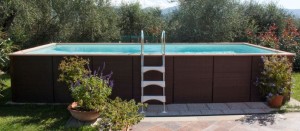Even though our New Mexico winters are sometimes mild compared to other parts of the country, it’s still necessary to close your pool for the winter to prolong the life of the pool and to help ensure the quality of the pool lasts for years to come. Taking the time to properly close your pool for the winter means it will be easier to open in the spring, saving you time, money, and effort. We’re here to help you simplify the process of winterizing your swimming pool. If you have any questions, please don’t hesitate to give us a call. We’re happy to help in any way that we can.

Why Winterize?
Temperatures can dip below freezing here in the Las Cruces area over the winter. If water is left in your pool equipment or in your pool lines, it will freeze and expand, causing significant damage to your pool equipment. Improperly winterizing your pool can lead to problems with the pool liner, filtration system, and plumbing.
DIY Winterizing Tips
Closing your pool for the winter is a process you can do on your own, and we’re available to help you along the way.
Clean the Pool Area
Before you winterize your pool, clean the areas all around it. Take this opportunity to prune trees, flowers, and bushes. Remove dirt, leaves, branches, and other debris from the areas surrounding the pool. You want the area as clean as possible so the pool water stays clean over the winter (and doesn’t grow algae).
Clean the Inside of Your Pool
Use a leaf skimmer or a pool rake to remove all of the debris from your swimming pool. Use your pool vacuum as needed so the water is as clean as possible (which will help keep your pool liner from discoloring over the winter).
Inspect Your Equipment
Check your pool liner and casing for cracks or leaks. You can repair small blemishes on your own; larger cracks or damaged areas may require professional attention. Move on to your pool pump, filter, fittings, gauges, and other equipment you have. Before you store them for the winter, you want to make sure they are in good working order.
Maintain Water Chemical Levels
Before you add your BioGuard Winterization chemicals, you’ll want to properly balance all of your pool chemicals. Maintaining aklalinity and pH levels should be done at least 24 hours before you move forward with winterizing your pool. Covering your pool before you know the chemical levels are okay means you could open your pool in the spring and find it filled with algae.
 Winterize Your Pool Water
Winterize Your Pool Water
Using BioGuard’s Arctic Blue(r) Winter Kits, you’ll get superior protection while your pool is winterized. The kit contains Arctic Blue Algae Protector, Arctic Blue Shock, and winterizing instructions.
Drain Your Pool
You want your pool water to be two inches below your pool’s return, or under your skimmer. You don’t want water to get inside the skimmer system over the winter, which could cause it to crack. If you don’t want to drain your pool, see if a skimmer plug is an option.
Disconnect Equipment
Drain your pump, filter, and pool heater. Disconnect your plumbing hoses. Remove pool accessories (steps, ladders, lighting). Store all of your pool equipment in a covered location so it doesn’t get damaged over the winter.
Add an Air Pillow
A heavy-duty air pillow in the center of your pool will help keep your pool cover from being weighed down by water, snow, ice, and debris.
Cover Your Pool
Remove dirt and debris from your winter pool cover so it doesn’t accidentally fall into your water, then cover it up for the winter. Make sure the pool cover is secured according to the manufacturer’s recommendations.
Secure the Area
Make sure all gates are locked and fencing is secured so unwanted guests don’t wander into your pool area during the winter months.
